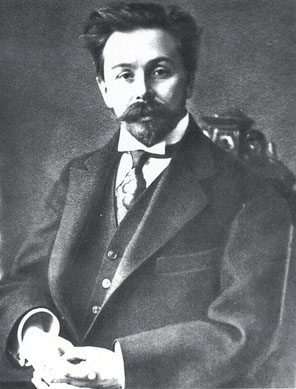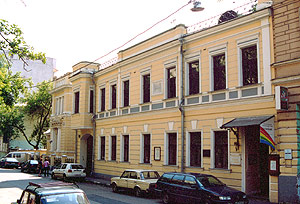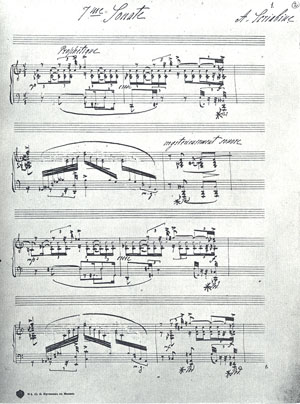Alexander
Scriabin
(1872 - 1915)
by Don Robertson
©
2005 by Rising World Entertainment
|

|
|
| The
Russian composer Alexander Nikolayevich
Scriabin was born on Christmas Day 7 January 1872, and
died on Easter, 14 April, 1915. He was very, very famous
during his lifetime, one of the greatest pianists every,
but almost forgotten after his death. He left behind a
body of piano and compositions, a few orchestral
works, a beautiful piano concerto, and five great
symphonies, and these were little understood by most
people. He continued to be a part of the classical music
activities in Russia, but it was the outside world that
neglected him until recently. Today, there is worldwide
resurgence of interest in his music, and also in his
ideas. |
And there should be a resurgence, because Scriabin was
one of the greatest composers of the 20th Century,
creating a new kind of music and musical philosophy that
was never known before, and is still not understood
today.
Scriabin's earliest influence was Chopin, and his
earliest piano |

Scriabin's home in Moscow, now the
Scriabin Museum.
|
pieces
were similiar in title and length to Chopin's: preludes, etudes, mazurkas. Many critics
branded Scriabin's earliest works as "diluted
Chopin." But nothing could be further from the
truth. Scriabin's lush, soaring sonorities were
something new, something fresh.
About 1899, Scriabin became absorbed in the music of Richard
Wagner and that year wrote his Symphony
Number 1.
Wagner's influence now had become stronger that Chopin.
The symphony was harmonically and melodically, a
rapturous wave of feeling and terminated with a vocal
final movement, the text a tribute in praise of Art. The
beautiful Symphony Number
2, followed in 1901.
After this, Scriabin began to find a new
voice, one that was completely unique, and this voice
was first heard in the forth piano sonata written
between 1901 and 1903. New tonalities were explored in
this work as root chords contained what musicians call flatted
fifths. This tonal structure became even more
pronounced in the fifth sonata of 1907 and in all the
intervening pieces between these sonatas.
Scriabin was also heavily
evolved in the teachings of Theosophy and in mysticism
and his whole life and his music leaned more and more in
this direction as time went on. He also became
preoccupied with the the creation of positive and
negative effects through music and his sixth sonata was
a negative one, so negative, in fact, that he refused to
play it. The seventh piano sonata composed during the
same time period (1911-1912) he called the "White
Mass," because he considered it of great purity.
Its harmonic structure was unlike any created by a
composer before.
|

Page One of the"The White
Mass" manuscript: |
Scriabin's forth symphony, composed between 1905 and
1907, was called the "Poem of Ecstasy as was a
single movement lasting a half hour, so it is really
more a poem than a symphonic work. With this work, the
composer wished to stimulate an experience of divine
ecstasy in the listener. He wrote a parallel poetic work
to help describe the music. It begins "/Spirit,
/Winged with thirst for life, /Is drawn into flight /On
the summits of negation. /There, under the rays of its
dream, /Emerges a magical world Of heavenly forms and
feelings /Spirit playing, /Spirit desiring." |
Scriabin once said
to a friend, "When you listen to 'Ecstasy' look
straight into the eye of the Sun!" The Poem of
Ecstasy was followed in 1909-1910 by Prometheus,
"The Poem of Fire." This work, with a
completely unorthodox harmonic structure, had a part
written in the score for a light keyboard, a
keyboard that would be connected to a lighting system
that flooded the concert hall with colored lights, the
colors defined by the keys pressed on the keyboard and
determined by the score.
Scriabin's greatest work was to be called
the Mysterium and it would cause a transformation
in the listeners. It would contain words, music, dance
as well as perfumes and sensations of touch and taste.
He worked on the plan for this work throughout the last
years of his life. He died prematurely at age 43.
Scriabins' music from the forth sonata on
is a mixture of negative and positive, though he never
mixed the two in a single piece or movement. The ninth
sonata he called the "Black Mass," but the
eighth and final tenth, are luxurious travels in the
upper astral planes. Of Scriabin's music, Manly Palmer
Hall said "One of the most truly spiritual of all
musicians was Scriabin, but he must be approached with
caution by those whose emotional lives are
disorganized." Corinne Heline had this to say:
"Scriabin was a true messenger and prophet of the
Aquarian Age." |
| In
the history of harmony in Western culture, there has
been an ever-expanding movement "up" the
harmonic overtone series. During the Renaissance
major, minor and dimished triads were used in the music
at first, then the 7th was allowed under very specific
circumstances. The 7th was liberated at the beginning of
the Baroque
era and throughout that era chords consisting of 1st,
3rd, 5th and 7th notes of the scale (example: G,B,D,F)
were used as a part of the harmony. Composers in
Beethoven's era began using 9th chords, add ing one more
note (G,B,D,F,A), however all five notes were not really
used together. It was probably Liszt
who began freeing ninth chords as seventh chords had
been liberated before, and this inspired Wagner
who used them freely. Wagner inspired the French
composers who began using straight ninth chords.
From this base, a number of French composers began
experimenting with even higher notes of the harmonic
series. Most of these composers are unknown today, and
only Debussy succeeded
in introducing a new music to the Western world using
chords of the ninth and beyond. However, there were two
composers who developed music harmonically beyond the
9th chord. The other was Scriabin, who went beyond
Debussy in his explorations and brought to us the first
music from astral dimensions, music based on these
higher partials. Which pieces of music? Works from later
in his life: The 8th and 10th Piano Sonatas. |
Scriabin
on the Web The
Scriabin Society The
Scriabin Museum in Moscow Anthemium Aspen
Site MP3
Examples ->
Impromptu, Opus 14, No 2
->
Impromptu, Opus 12, No 2
->
Mazurka, Opus 25, Number 2
->
Prelude, Opus 13, Number 1
->
Prelude, Opus 13, Number 3
->
Prelude,
Opus 13, Number 5
->
Prelude,
Opus 15, Number 1
->
Prelude,
Opus 15, Number 3
-> Prelude,
Opus 15, Number 4
->
Prelude, Opus 15, Number 5
->
Prelude, Opus 16, Number 4
->
Prelude, Opus 22, Number 1
->
Prelude, Opus 33, Number 1 Scriabin
Books Scriabin:
A Biography
Fabian Bowers
Dover Publications Scriabin:
Artist and Mystic
Boris de Schloezer
Translated by Nicolas Slonimsky
University of California Press
|

